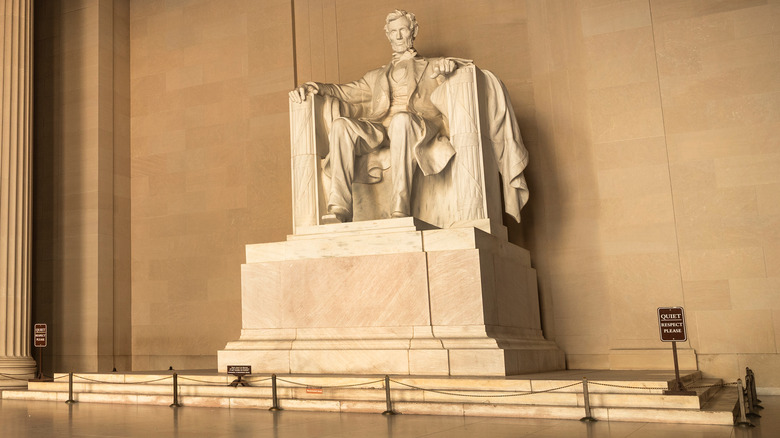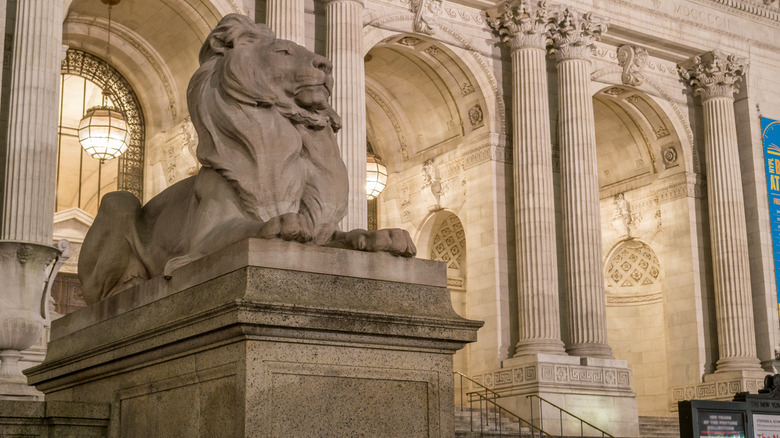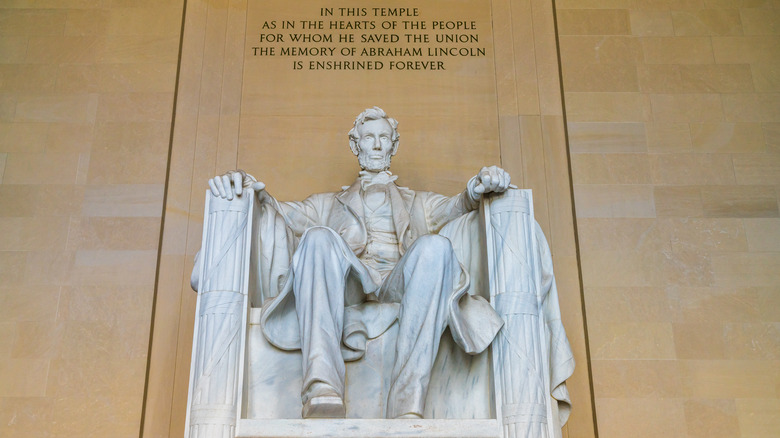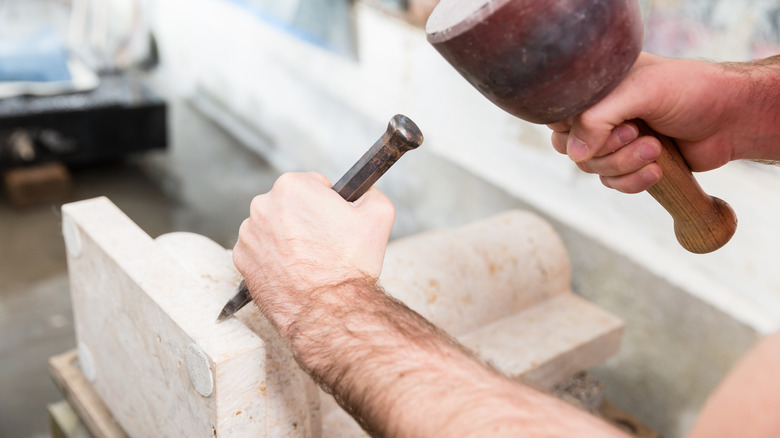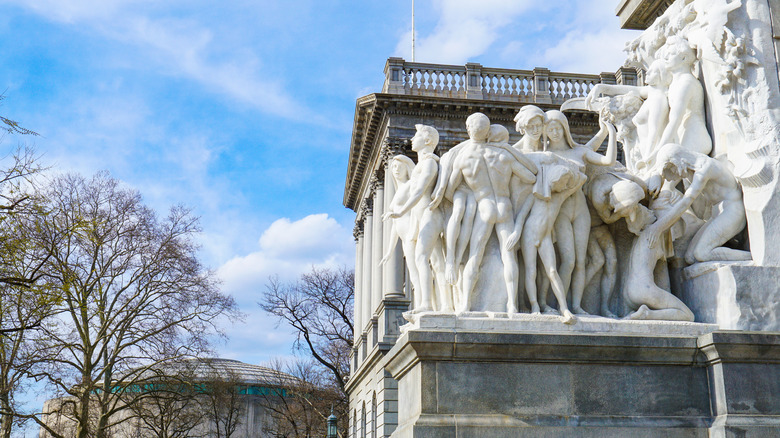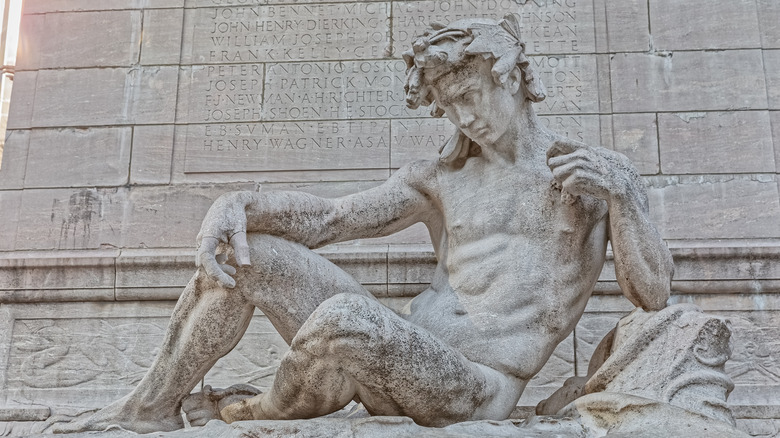Who Carved Lincoln's Statue In The Lincoln Memorial?
Ever since it opened to the public in 1922, the Lincoln Memorial has become a classic landmark of Washington, D.C. (via History). It's located behind the Reflecting Pool, on the west end of the National Mall, where thousands of tourists visit every year (via Washington D.C.). Creating a monument as big as the Lincoln Memorial was no small feat — Lincoln's statue ended up being 19 feet tall, and weighing 175 tons.
As The National Park Service reports, Daniel Chester French first developed the original idea for the design of the Lincoln Memorial statue. He studied old photos of Honest Abe, and chose to make him look serious, while at the same time evoking peace with one opened palm. French designed several different plaster models, per The New York Times, including the final one that was seven feet tall.
So who could make French's design into a larger-than-life statue?
Choosing the right artists
In 1918, one prominent family of artists was chosen to bring the marble details to life (via The National Park Service). French had a specific group of artists that he trusted could do justice to the project. He commissioned the family to carve the Lincoln Memorial based on his designs. Apparently, French was such a fan of these artists that he had them carve nearly all of his works of art (via Lehman College).
The Lincoln Memorial took eight years to complete. The project required 28 blocks of white Georgia marble, which were carefully carved to fit together and highlight even the tiniest details, reports The National Park Service. The family carved the Lincoln Memorial at their studio in New York, and then brought the 28 pieces to Washington D.C. The end result was astounding: The marble blocks fit together nearly seamlessly. Alongside the actual Abraham Lincoln statue, the artists also created tripods for the exterior staircase.
During the early 1900s, detailed statues and reliefs were crucial aspects of building design. The New York Public Library reports that the family who created the Lincoln Memorial was responsible for numerous notable landmarks. In New York, the carvers sculpted works of art such as the famous marble lions outside the New York Public Library, 12 statues at the U.S. Custom House at Bowling Green, 30 statues for the Brooklyn Museum, and a glass relief at Rockefeller Center.
So who was this talented family of marble carvers?
The 'city beautiful era'
Guiseppe Piccirilli worked as a stone carver, and taught the trade to his children (via the New York Public Library). The Piccirilli family immigrated from Italy to America in 1888.
The six brothers, one sister, and their father and mother moved into a house on 142nd street in the Bronx (via Lehman College). They transformed the space next to their brownstone home into a stone-carving workshop — and it eventually expanded to take over an entire city block (via the New York Public Library). Their specialty was carving and cutting marble. Alongside their commissioned works, the artists created numerous original pieces that can be found among New York City's architecture.
It's hard to overstate the importance that gorgeous architecture held in the early 1900s (per Bespoke Concierge Magazine). "The late 19th and early 20th centuries [were] what we call the 'city beautiful era,' where there was a tremendous amount of attention being paid to embellishing buildings with architectural and sculptural detail," said Thayer Tolles, a sculpture and painting curator at the Metropolitan Museum of Art.
Masters of marble carving
The Piccirilli brothers were Attilio, Ferrucio, Furio, Getulio, Masaniello and Orazio, per The New York Times, and they were master marble carvers. Bespoke Concierge Magazine reports that two of the brothers, Furio and Attilio, trained at the prestigious Accademia di San Luca in Rome, Italy. In the early 1900s, American sculptors would generally send their designs to Italy to be cut into marble. So when the Piccirilli family arrived, they found lots of work waiting for them from American artists.
Artists could create a plaster mold, and then instead of sending it to Italy, they would commission the talents of the Piccirilli brothers to craft the design in marble. Mott Haven Herald reports that the Piccirilli family was also exceptionally skilled at the pointing method of sculpting.
Per The New York Times, the brothers were all close friends, and their studio was described as "a place of laughter and camaraderie." Attilio Piccirilli would cook huge spaghetti lunches for the entire crew. The family considered any artistic prize that one of them was awarded to be an honor for the whole family.
'Our souls are all the same'
Once, an interviewer said to the brothers, "It was odd that you all made up your minds to be sculptors" (via Lehman College). Maso Piccirilli replied, "There is no 'mind' to it. Our souls are all the same one."
The Piccirilli family were well-known artists, and John D. Rockefeller, Enrico Caruso, and Teddy Roosevelt were just a few of the important people who visited their studio in the Bronx (via Bespoke Concierge Magazine). Enrico Caruso, who was an Italian opera singer, would reportedly visit the studio and serenade the brothers as they worked.
According to Lehman College, Attilio Piccirilli would go on to co-found the Leonardo da Vinci Art School in Manhattan in 1923. Throughout his life, he supported young artists by inviting them to his studio to show them how professional sculptures made their masterpieces.
Interestingly, French wanted to carve the names of all the Piccirilli brothers into the Lincoln Memorial statue, reports History. But they refused his offer.
A lost legacy?
In the 1940s, the brothers began to die one after another, with the youngest brother dying in 1956 (via Bespoke Concierge Magazine). Their legendary studio in the Bronx was torn down, and for several decades it seemed that the Piccirilli legacy may be lost forever.
But Mott Haven Herald reports that a local retired teacher, Bill Carroll, rediscovered the Piccirilli's legacy after living in the same neighborhood in the Bronx for many years. He now often gives lectures about the Piccirillis to educate people about their artwork.
The brothers' work won't soon be forgotten. They're honored with a plaque at Brook Park in the Bronx, dedicated in 2001. And after creating some of the most revered marble sculptures in America, the Italian family was finally recognized for the lasting mark they left on the country they called home.
